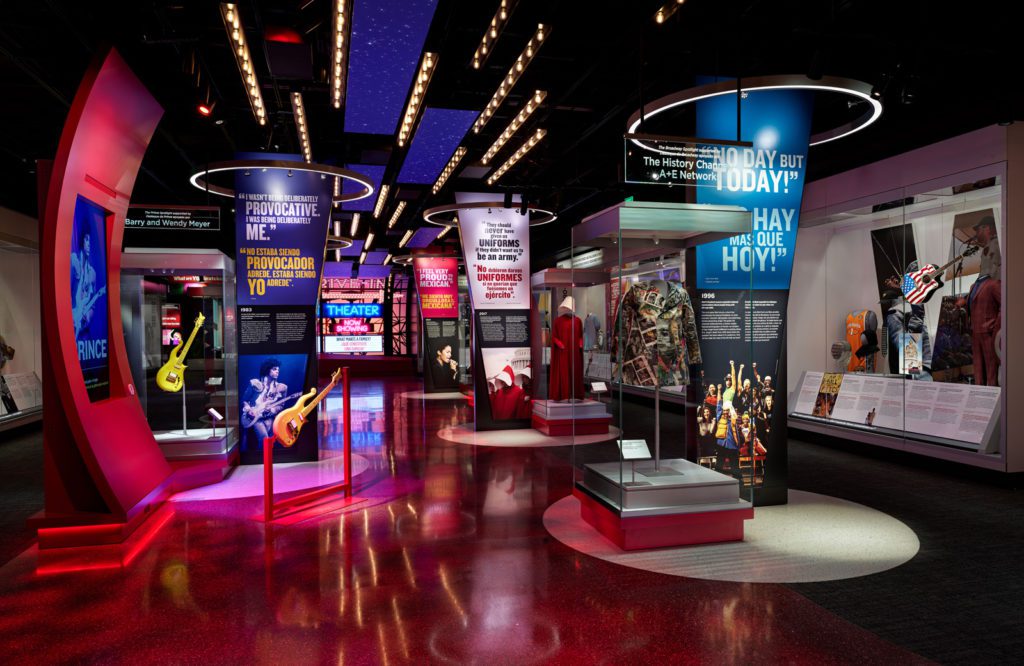Museum of American History Unveils ‘Entertainment Nation’
By • January 19, 2023 0 2092

Fantasy creations from Hollywood — R2-D2 and C-3PO costumes from “Return of the Jedi,” (1983) and Dorothy’s Ruby Slippers from “The Wizard of Oz” (1939) — are posed at the entrance of “Entertainment Nation/Nación del espectáculo” in invitation to enter the now opened exhibit at The Smithsonian Institution’s National Museum of American History.
The impressive presentation of 200 objects traces the history and ideas of American entertainment over the past 150 years. Unlike works in an art gallery, these objects were once part of life — used or worn — each holding backstories. Evoking personal memories or sparking emotions, when so viewed in broader framework of American history, they offer a chance to reflect on our shared cultural identity.
Starting with a display of circus posters from as early as P.T. Barnum in 1882, the path through our national entertainment history is not just a nostalgic trip down a yellow brick road. Underlying themes of racism, nativism and sexism in American society are noted throughout in the display text.
“Making Sense of Modern times,” (1900s-1940s) covers the broadest expanse of time through the depression era and two world wars. The diversity of musical mementos includes a record by blues singer Bessie Smith (1923), Frank Sinatra’s bow tie (1942) and photography of Marian Anderson in concert at the Lincoln Memorial (1939).

Tenor saxophone, made by Selmer, belonged to John Coltrane. Courtesy Smithsonian.
Sports are a major theme throughout. Consider for a moment their impact. We now cast our eyes on objects like Joe Louis’s boxing gloves resting in a display case. Louis who lost that first match to Max Schmeling in 1936, in a re-match two years later would defeat the icon of white supremacy in a historic fight listened to on radio, unseen by many Americans to whom it was most significant.
“Seeking Truth and Justice in the Atomic Age (1940s-1980)” has memorabilia from political satire like Stanley Kubrick’s “Dr. Strangelove” (1964) and drama about witch hunting like Arthur Miller’s “The Crucible” (1953). There’s an anti-Black segregationist leaflet (early 1960s) titled “Don’t Buy Negro Records.” The display of costumes ranges from Diana Ross’s Supremes’ dress to Muhammad Ali’s robe to Zero Mostel’s role as Tevye in “Fiddler on the Roof “(1964).
“Breakouts and Breakdowns” (1970s-2000 )includes two items from the Estefans: a costume worn by Gloria Estefan and a conga used by Emilio Estefan. (Both were awarded the James Smithson Bicentennial Medal on Dec. 8, 2022, for their contributions to the American experience through music along with Dave Grohl, Nirvana drummer and founder of Foo Fighters, and Susan Tedeschi, co-founder of Tedeschi Trucks Band.)
Glittering movie screens in “Confronting Infinite Choices & Challenging Divides” bring the exhibit up to date. Micro-galleries throughout the exhibit include “What’s Your Anthem?” with musical instruments and recordings, “What Are You Watching?” with items from Howdy Doody, the Mickey Mouse Club, the Muppets, Sesame Street and Mr. Rogers’s. There’s also “What’s so Funny?” which spans from mail order costumes for performers in blackface minstrel shows in 1905 to a Richard Pryor album in the 1970s, “Women in Sci-Fi and Fantasy” case and props from the television show “All in the Family.”
The New Culture Wing
There’s more in the new Culture Wing at the Smithsonian’s National Museum of American History.
“(re)Framing Conversations: Richard Avedon Photographs 1946-1965,” an inaugural exhibition, showcases 20 iconic black-and-white images with two rotations (the first one until fall of 2023 to be immediately followed by another 20 new Avedon photos in exhibit until 2024). A room with historic period magazines on display invites a chance to reflect on the celebrities from politics to performance of that era.
“Pause & Replay” is a space to sit, recharge and reminisce about video games and take a nostalgic look through archival images, animations and retro games
A Corridor Case — objects starting with Route card (1905), Edison Vitascope No. 1 projector (1896), Studio microphone from WANN (late 1940s), a Hotpoint portable television (1957), a Dolby Cinema Processor CP-100 (1975), Jerrold “Starcom II” cable box (1982), a camcorder (1986) and Steve Lacy’s iPhone 5 (-2013) — is quick reflection to consider media changes in the span of a century.
“Entertainment Nation/Nación del espectáculo” at the Museum of American History on the National Mall is a permanent collection, planned to be on display for the next twenty years with changes in objects over time. Filled with wonders from the past, it gives pause to contemplate what could be the coming attractions in our every expanding environment of entertainment.

